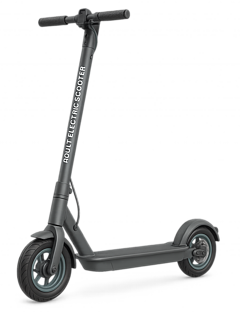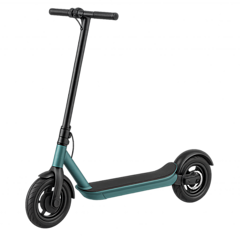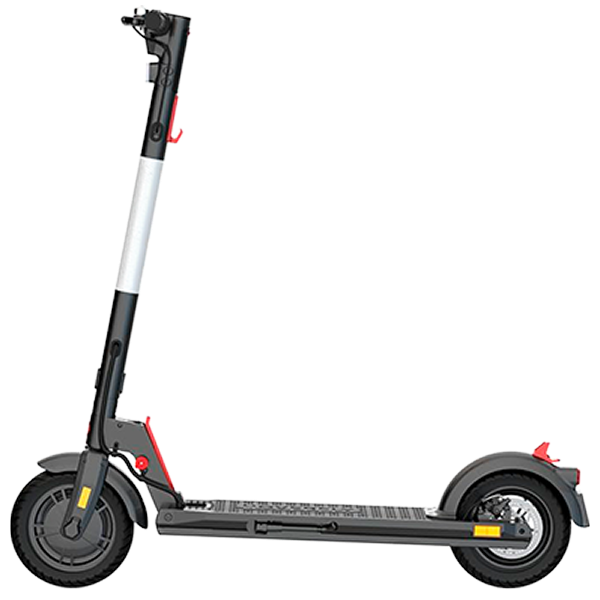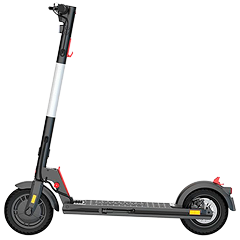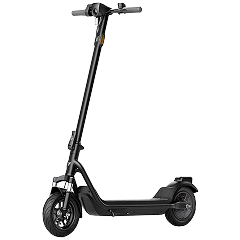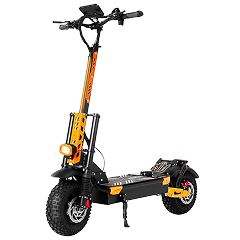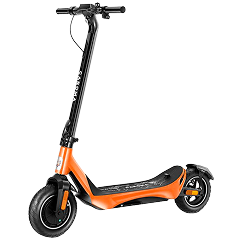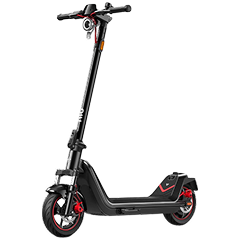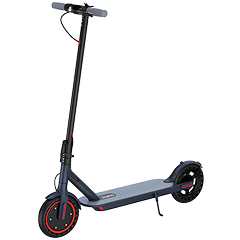Electric scooters are designed with portability in mind, which generally means compact dimensions. And while this works great for average-height riders, it can create challenges for taller adults who might feel cramped or uncomfortable on standard-sized scooters. The good news is that there are electric scooters out there that cater to us tall folks (or at least can be tweaked to fit). You just need to know what to look for.
In this guide, we’ll break down all the key factors tall riders should consider, that is, handlebar height and width, deck size, weight capacity, frame strength, motor power, battery range, suspension, tires, and more. We’ll also share some tips on measuring for the right fit, ways to adjust a scooter to suit your height if you’re pushing 6’4″ or taller, and answer a few common questions tall riders usually have.
Just a heads up before we dive in, if you’re on the taller side (especially 6’4″ and above), you’re probably also heavier than average, which means you need to think beyond just handlebar height. Performance scooters often work best for tall riders because they’re built bigger and stronger across the board. You get the height you need, plus the power and structural strength to handle your size properly. You want the scooter to fit you, not the other way around.
Quick Reference: Key Features for Tall Riders
Below is your cheat sheet for what to look for when shopping as a tall adult.
If a scooter checks most of these boxes, it’s probably going to feel a lot better for a tall rider than the average little commuter.
What to Check on Electric Scooters for Tall Riders
Here’s what to zero in on:
Handlebar Height & Width
Handlebar height is the number one factor for tall riders. Nothing ruins a ride faster than having to fold yourself in half just to grab the handles. Ideally, the bars should sit somewhere around your waist (or just below your belly button) when you’re standing on the deck.
At that height, you can stand upright with a slight bend in your elbows (about 100–120°), which keeps your shoulders relaxed and lets you steer with ease. Your wrists stay straight, acting like natural shock absorbers for bumps, and you won’t be straining your back or neck on longer rides.
Most electric scooters feature handlebar heights ranging from 35 inches (perfect for shorter riders) up to about 43 inches (suitable for tall riders). However, the majority fall within the 37-39 inch range, which tends to work okay if you’re around 5’8″ to 5’10”. But if you’re over 6 feet tall, you’ll want 40+ inches of deck-to-bar height for a truly comfortable fit. Many performance scooters offer handlebars in that 40–42-inch range from the deck, which is why taller riders often gravitate towards those models.
How to Calculate Handlebar Height (When It’s Not Listed)
When shopping online, you won’t have the scooter physically available for measurement, so you’ll need to work with the manufacturer’s specifications. However, most manufacturers don’t include handlebar height in their spec sheets, but they’ll always list the scooter’s unfolded height and tire size. From these two measurements and occasionally deck clearance, you can calculate the approximate handlebar height.
Method 1:Using Deck Clearance
If the specifications include deck clearance (distance from ground to deck), subtract this directly from the unfolded height:
Handlebar Height = Unfolded Height – Deck Clearance
(Note: We haven’t accounted for the deck’s thickness, but this is typically minimal.)
This method typically gets you within an inch of the actual measurement, which is accurate enough to determine if a scooter will suit your preferred riding posture.
Method 2: Using Wheel Size
If clearance is missing, estimate it from the wheel size. This depends on where the tire sits in relation to the deck – is it positioned midway up the deck, or does the deck sit higher or lower relative to the wheel’s center? On most electric scooters, the deck sits slightly above the axle line, averaging about 80% of the wheel diameter:
Handlebar Height = Unfolded Height – (0.8 × Wheel Diameter)
For off-road scooters, the platform sits much higher – the deck often lines up with, or even rises slightly above, the very top of the tire. Treat the deck height as the full wheel diameter here. So the formulae will be
Handlebar Height = Unfolded Height – Wheel Diameter
How to Determine Your Ideal Handlebar Height
To find your optimal handlebar height, stand on a level surface wearing your normal riding shoes. Keep your feet shoulder-width apart and relax your shoulders. Have someone measure from the floor straight up to the top edge of your navel.
This measurement establishes your comfort zone and typically falls between 41-50 inches (104-127 cm) for most tall adults. As a quick estimate, you can confirm this by multiplying your total height by 0.618, though individual proportions can vary.
Based on the measurement above minus a few inches, we can typically come up with a table that tries to match the various rider heights to the specific handlebar height that will be comfortable based on what we have available on the market:
Your arm span also plays an important role in finding the right fit. If you’ve got long arms relative to your height, you’ll have more flexibility with handlebar height. Short arms relative to height mean you need to be pickier about getting the exact right measurement.
Is an Electric Scooter Handlebar Height Adjustable?
Some scooters come with telescopic stems that let you adjust height by a few inches. These are more common on entry-level models and kids’ scooters. The problem? Telescopic stems can flex under load and introduce a potential failure point. That’s why most performance scooters skip this feature in favor of fixed, solid stems.
If your scooter has a fixed stem that leaves the handlebars too low, several bolt-on solutions can add the height you need.
First is a stem extension, which is a cylindrical spacer that bolts between the steering tube and handlebar clamp, raising the entire cockpit about 2–4 in (5–10 cm) while keeping your original bars.
Second is a bar riser, which is a machined spacer that clamps between the stem and handlebar, lifting the grips by roughly the same amount without touching the steering tube. For riders over 6’4″, these might be your only options short of buying one of the few super-tall scooters available.
You can also swap the handlebars entirely. Different bars have different “rise” measurements (how much they curve upward). Switching from flat bars to ones with more rise (high-rise handlebars) can gain you 1-3 inches.
Before purchasing any height modification solution, you must verify critical compatibility factors to ensure safe operation. First, ensure that all clamping and locking mechanisms match your scooter’s specifications, as different manufacturers use varying clamp diameters and mounting styles.
Most importantly, check that brake cables, throttle wires, and display connections have sufficient length to accommodate the increased height. You really don’t want a situation where the brake hoses and display cables are pulled tight whenever you make a turn, as this will create premature wear on cable housings and will also affect your handling, by restricting steering movement.
Handlebar Width
While we’re talking bars, let’s not forget handlebar width. Taller riders often have broader shoulders or just appreciate a wider stance for stability. Narrow bars make the scooter feel twitchy and force your arms into an uncomfortable position. You want bars at least as wide as your shoulders, preferably a bit wider.
Say the rider’s shoulder width is about 20 inches, a 22″ – 23″ wide bar would work great, as you do not want them to be too much wider than shoulder width. Most standard scooters come with bars around 20-22 inches wide, but tall riders often benefit from 24 inches or more. Wider bars give you better leverage for steering and more stability at speed. They also let you spread your hands out for comfort on longer rides.
If a scooter you love has everything right except narrow bars, you can usually swap them out for wider aftermarket handlebars (as long as they fit the clamp). It’s a relatively cheap upgrade that can dramatically improve control.
Deck Size
Though not a strict rule, taller people usually have bigger feet. A tiny deck will force you to contort your legs or stand sideways, neither of which is ideal for balance or comfort.
Many standard scooters have decks around 17–18 inches long and maybe 6-7 inches wide. That can feel really cramped if you’re over six feet or pushing size 10 shoes. For tall riders, I’d recommend looking for a deck that’s at least 20 inches long and 8 inches wide of usable space (excluding space occupied by charging ports, stem mounts, or other hardware). This gives you enough room to keep your feet staggered or side-by-side without toes and heels hanging off the edges.
Why is deck size so important? First, it lets you adjust your stance during longer rides. If your legs are locked into one narrow position, they’ll get tired or sore faster. A longer deck lets you move one foot forward or back, or shift angles to stay comfortable. A wider deck makes it easier to have a shoulder-width stance, which is great for stability (and for accommodating bigger feet). The extra room also helps distribute your weight more evenly, which can improve handling.
Some scooters even have a kickplate or raised back platform that extends the deck, giving your rear foot a place to rest at an angle. A kickplate can effectively lengthen your foot platform and also helps with leverage when steering or hopping off curbs.
Deck strength matters too. Your extra weight and leverage put more stress on the deck. Look for reinforced designs with thick aluminum or steel construction. A flexing deck is uncomfortable, dangerous, and kills ground clearance when it sags.
Weight Capacity (Max Rider Weight)
Height isn’t the only thing that can push a scooter to its limits; many tall riders have a larger body mass as well. Every scooter has a maximum rider weight rating (often around 220 lbs / 100 kg for regular commuter models, and 265+ lbs / 120 kg for performance models). If you’re a tall adult, it’s worth checking this spec, especially if you’re over 200 lbs.
That’s because riding a scooter near or over its weight limit can really hamper its performance and durability. The motor has to work harder to get you moving, the battery drains faster, and the frame and stem endure more stress. You’ll notice slower acceleration, and you might not hit the advertised top speeds or range figures.
As a rule of thumb, try to be at 85% or less of the scooter’s max load for the best experience. So if you weigh 220 lbs, look at scooters rated for around 260 lbs or more. That buffer means the scooter isn’t maxed out every time you hop on, which is better for its long-term health (and your safety).
Exceeding the weight limit not only beats up the scooter’s components but can also lead to things like instability (wobbly stems or decks). So, pick a scooter with some breathing room on the weight capacity.
Structural strength also goes beyond just weight ratings. Check for:
- Thick-walled tubing in the stem and frame
- Reinforced folding mechanisms with zero play when locked
- Quality welds that look smooth and consistent
- Dual-stem designs or extra bracing
- Better heat dissipation for electrical components
The scooter itself will probably weigh more when it’s built for tall, heavy riders. Don’t be surprised if your ideal scooter weighs 60-80 pounds. That’s the price of proper construction.
We’ve covered weight considerations in depth in our guide to electric scooters for heavy riders. You can check out that comprehensive resource for additional factors to consider if you’re on the heavier side as well, including specific recommendations for frame strength, motor sizing, and battery requirements for larger riders.
Motor Power
Taller and potentially heavier riders need adequate power to maintain performance. The additional weight and wind resistance (due to larger frontal area) can significantly impact acceleration and hill-climbing ability.
1000W continuous power should be your minimum. Not peak power, but actual continuous rated power. Dual motors are even better, giving you power to both wheels for better traction and hill climbing.
To get a better understanding of these performance electric scooters, check out our comprehensive guide to the fastest electric scooters. You’ll find detailed insights into what specifications and features you need for optimal performance.
Battery & Range
Scooter range is another spec that can be misleading if you’re a tall/heavier rider. Manufacturers might advertise “up to X miles of range,” but that’s usually with a lightweight rider (Approx. 165 lbs), on flat terrain, at a slow pace. Add a larger rider and higher speeds or hills, and the range drops significantly. More mass means the battery has to supply more juice for every acceleration and to maintain speed. If you’re also taller (catching a bit more wind), that’s extra drag that drains the battery faster.
The solution? Go for a bigger battery if you can, especially if you plan to cover longer distances. Look for at least 600 Wh of battery capacity, though 1000 Wh or more is really where you want to be. Higher voltage systems (52V, 60V, 72V) deliver power more efficiently, helping maintain performance under load.
If range is your top priority, there’s also our guide to the longest range electric scooters that covers what you might need for extended riding without frequent charging stops.
Suspension
Good suspension (spring, rubber, air, or hydraulic shock systems) helps absorb bumps so your knees and back don’t have to. This is especially crucial if you plan to ride on rough city streets or cracked sidewalks.
If possible, get a scooter with suspension on both wheels (dual suspension) for the smoothest ride. At the very least, having suspension on either the front or rear wheel is better than none. A basic spring suspension is certainly better than a rigid frame, but heavier riders can compress springs a lot, so look for models with adjustable or heavy-duty suspension if you can. The idea is to have some cushion between you and the road, which keeps your ride more predictable by helping the tires stay in contact with uneven ground.
Tires
Last but certainly not least, let’s talk tires. Along with suspension, tires play a huge role in ride comfort and stability. I always suggest going with larger pneumatic tires. The reason is simple: air tires act as another layer of suspension and generally provide better grip.
For tire size, a bigger tire (10 inches in diameter or more) will roll over cracks and small bumps more smoothly than a tiny 6- to 8-inch solid wheel on a budget scooter. The larger tires also have better stability and help maintain speed efficiency.
Taller riders also tend to feel more stable on scooters with a wider wheelbase and chunkier tires. Many heavy-duty or performance models come with 10×3-inch tires. That wider tire gives a nice contact patch with the ground, improving traction and handling. You might not need an ultra-fat tire, but something in the 2.5–3-inch width range is a good benchmark for stability.
Avoid scooters that have those small, solid rubber tires (unless you only ride on ultra-smooth surfaces). They can’t go flat, but they also don’t absorb any bumps, so you’ll feel every jolt.
Additional Considerations for Tall Riders
Storage and Transport
Electric scooters designed for taller riders inevitably tend to be larger and heavier than their compact counterparts, which creates practical challenges beyond just the riding experience. These larger scooters weigh 60-80 pounds or more, making them significantly bulkier than standard commuter models that typically weigh 25-40 pounds.
This increased size and weight means they might not be ideal for intermodal transportation scenarios where you need to carry the scooter up stairs, onto public transit, or into office buildings. The folding mechanism, while present on most models, results in a folded package that’s still substantially larger than compact scooters, potentially making storage in small apartments, car trunks, or office spaces more challenging.
If portability is your main concern and you’re willing to explore lighter alternatives that might work with modifications, check out our comprehensive guide to the lightest electric scooters.
Price Range
Entry-level options that accommodate taller riders generally start around $1,000, though these often give you the minimum performance you might need. The sweet spot for most tall riders falls in the $1,500-$2,500 range, where you can find scooters with proper dimensions, adequate power systems, and quality construction without entering the ultra-premium category.
High-performance models designed for demanding riders can extend to $4,000 or more, featuring top-tier components, dual motor systems, large battery packs, and advanced suspension systems that justify the premium pricing.
FAQs
What Are the Best Electric Scooters for Tall Riders?
If you’re a tall rider, go straight to performance electric scooters. They cost more, but they’re built for you. These scooters typically offer:
- 40-43 inch handlebar heights
- 265-330 pound weight capacities
- Dual motors with 1000W+ total power
- Large batteries with 1000Wh+ capacity
- Spacious decks with adequate foot room
- Large battery capacities (800Wh+)
- Quality suspension systems
- 10-11 inch tires
- Reinforced frames and components
You get everything you need without compromises or modifications.


